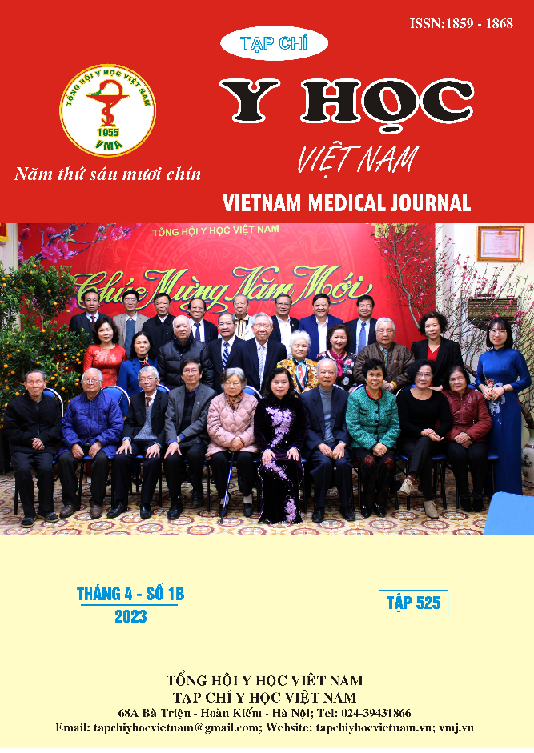BẤT THƯỜNG NHIỄM SẮC THỂ PHÔI THEO NHÓM TUỔI CỦA BỆNH NHÂN VÔ SINH ĐIỀU TRỊ THỤ TINH TRONG ỐNG NGHIỆM
Nội dung chính của bài viết
Tóm tắt
Mục tiêu: Đánh giá bất thường nhiễm sắc thể (NST) phôi theo nhóm tuổi của bệnh nhân vô sinh có chỉ định điều trị thụ tinh trong ống nghiệm kết hợp sàng lọc di truyền trước chuyển phôi. Đối tượng và phương pháp nghiên cứu: Mô tả tiến cứu trên 661 phôi túi của 186 bệnh nhân hiếm muộn có chỉ định điều trị thụ tinh trong ống nghiệm (In vitro fertilization/IVF) kết hợp sàng lọc di truyền trước chuyển phôi ((Preimplantation genetic testing for aneuploidies/PGT-A). Kết quả: Tỉ lệ phôi mang NST bình thường tương đương nhau giữa nhóm I (dưới 30 tuổi) và nhóm II (30-35 tuổi) lần lượt là 51,1 và 54,1% (P(1-2)=0,613); thấp nhất ở nhóm III (>35 tuổi) với tỉ lệ 35,7%, P(1-3); P(2-3) <0,05. Tỉ lệ phôi bất thường NST khác biệt không có ý nghĩa giữa nhóm I và nhóm II (P(1-2)=0,310), tăng cao có ý nghĩa thống kê ở nhóm III với tỉ lệ là 47,2% (P(1-3); P(2-3)<0,001). Bất thường số lượng NST có xu hướng tăng theo sự gia tăng của tuổi mẹ (p<0,05), trong khi đó bất thường cấu trúc NST xu hướng ngược lại mặc dù chưa thấy sự khác biệt có ý nghĩa (p=0,148). Tỉ lệ phôi khảm ở ba nhóm lần lượt là 25%;16,5%; 17,1% (P(1-2)=0,069; P(1-3)=0,101; P(2-3)=0,843). Trong các phôi bất thường số lượng NST, tỉ lệ phôi monosomy và trisomy là tương đương ở ba nhóm (P(1-2);P(1-3); P(2-3)>0,05). Kết luận: Trên đối tượng bệnh nhân vô sinh có chỉ định điều trị IVF – PGT-A, tỉ lệ phôi bất thường NST tăng có ý nghĩa thống kê khi tuổi người mẹ trên 35. Trong các loại bất thường NST phôi, bất thường số lượng NST tăng có ý nghĩa thống kê theo sự gia tăng của tuổi mẹ. Chưa thấy sự khác biệt có ý nghĩa về tỉ lệ phôi bất thường cấu trúc NST, tỉ lệ phôi khảm cũng như tỉ lệ phôi monosomy, trisomy giữa các nhóm nghiên cứu.
Chi tiết bài viết
Từ khóa
Abnormal chromosome, RIF (recurrent implantation failure), RPL (recurrent pregnancy loss), advanced maternal age.
Tài liệu tham khảo
2. Liu X-Y, Fan Q, Wang J, et al. Higher chromosomal abnormality rate in blastocysts from young patients with idiopathic recurrent pregnancy loss. Fertility and Sterility. 2020;113(4):853-864.
3. Bashiri A, Halper KI, Orvieto R. Recurrent Implantation Failure-update overview on etiology, diagnosis, treatment and future directions. Reprod Biol Endocrinol. 2018; 16(1):121.
4. Barbakadze L, Kristesashvili J, Khonelidze N, Tsagareishvili G. The correlations of anti-mullerian hormone, follicle-stimulating hormone and antral follicle count in different age groups of infertile women. Int J Fertil Steril. 2015;8(4):393-398.
5. Kozlowski IF, Carneiro MC, Rosa VBD, Schuffner A. Correlation between anti-Müllerian hormone, age, and number of oocytes: A retrospective study in a Brazilian in vitro fertilization center. JBRA Assist Reprod. 2022;26(2):214-221.
6. Munné S, Held KR, Magli CM, et al. Intra-age, intercenter, and intercycle differences in chromosome abnormalities in oocytes. Fertil Steril. 2012;97(4):935-942.
7. Cimadomo D, Fabozzi G, Vaiarelli A, Ubaldi N, Ubaldi FM, Rienzi L. Impact of Maternal Age on Oocyte and Embryo Competence. Front Endocrinol (Lausanne). 2018;9:327.
8. Sainte-Rose R, Petit C, Dijols L, Frapsauce C, Guerif F. Extended embryo culture is effective for patients of an advanced maternal age. Sci Rep. 2021;11(1):13499.
9. Yeoh MH, Chen JJ, Sinthamoney E, Wong PS. Clinical outcome: the relationship between mosaicism and advanced maternal age with the use of Next Generation Sequencing (NGS). Reproductive BioMedicine Online. 2019;38:e48.
10. Gui J, Ding J, Yin T, Liu Q, Xie Q, Ming L. Chromosomal analysis of 262 miscarried conceptuses: a retrospective study. BMC Pregnancy Childbirth. 2022;22(1):906.


